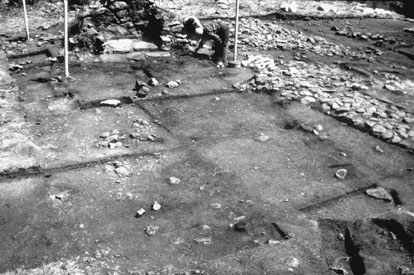

 | Page 117 |  |
Karskens and Thorpe (1992) proposed a series of broad integrative research questions for addressing the archaeology of Sydney, and the questions were taken up by the Sydney Cove Authority and Godden Mackay Logan Heritage Consultants in the innovative and highly successful Cumberland/Gloucester Streets project (Karskens 1996, 1997, 1999). Similar collaborative work between archaeologists and historians developed in Melbourne around the assemblages from the inner-city site of Little Lon (Mayne and Lawrence 1998; Murray and Mayne forthcoming).

The excavated shepherd’s hut at Burghley, northwest Tasmania, built in 1827
(Courtesy of Tim Murray)
At the same time, cultural heritage management concerns were requiring thematic studies geared toward the creation of heritage inventories, which continued to stimulate work in rural areas. Included were studies of the mining, whaling, and pastoral industries (Bell 1987; Kostoglou and McCarthy 1991; Pearson 1983). Research also continued in other areas of long-standing interest, such as industrial archaeology (Jack and Cremin 1994), rural elites (Connah 1986; Wilson 1988), and the Chinese (Bell 1993; Gaughwin 1993; McCarthy 1988). Work was carried out on a number of major convict sites, including the Great North Road between Sydney and Newcastle (Karskens 1984); Hyde Park Barracks in Sydney; and Port Arthur, Tasmania (Davies and Buckley 1987; Egloff 1984). Most research has emphasized male convicts, but historians and archaeologists have begun to explore the experiences of female convicts (Casella 1996, 1997).
Contact archaeology also began to attract more attention as researchers investigated the maintenance of Aboriginal culture despite the trauma of postcontact dislocation (Birmingham 1992; Colley and Bickford 1996; Mulvaney 1989). In the 1990s, research broadened to include a variety of postcontact sites, from traditional rock shelters and shell middens containing artifacts of European origin (Colley 1997) to sites such as Burghley, Tasmania, which was abandoned by English-speaking shepherds but reoccupied by Aboriginal people (Murray 1993), to pastoral stations where Aboriginal men worked as stockmen and Aboriginal women worked as housemaids, cooks, and nannies.
 |  |